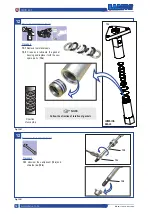
The pneumatic transfer pumps work with a compressed air motor
that moves the piston vertically from top to bottom and viceversa.
The product is suctioned by the lower pump and carried to the exit.
The structure of the
“pumping unit”
(suction valve, pump piston,
material seal gaskets)
permits the supply of material when the
piston is in the ascending or descending phase.
The flow rate of a pneumatic piston pump depends on the quantity
of material that it releases during each cycle and on the
number of cycles that it completes
(the cycle is the full stroke of
the piston in both direction).
The ratio 60:1 means that the outlet pressure of material is 60
times higher than the pump feed air pressure.
WORKING PRINCIPLE
•
Lubrication
•
Ink transfer
•
Transfer and paint circulation
•
Dosing of chemical products
•
Protective coatings
•
Fluid transfer
•
Filling-emptying barrels
•
Oil supply
•
Graphic arts, printing, flexography
•
Tanning
•
Fluids evacuation
•
Water and liquid waste removal
•
Woodworking and plywood
•
Supply ceramic pastes screen printing machines
•
Power atomisation heads for wetting and humidifying
•
Supply of machines for coating and laminating
•
Electrical and Electronics for component isolation
•
Woodworking and plywood
•
Cosmetic, construction, mechanics,paper, shipbuilding,
automobile industries
•
Carpentry, Railways
FIELDS OF APPLICATION
•
Alcohol
•
Sealants, Silicones, Greases
•
Inks
•
Mastics, Glues
•
Lubricants
•
Adhesives and self-adhesives
•
Paints, Resins, Solvents
•
Gear oils
•
Motor oils
•
Filler
•
Materials for tanneries
•
Waterproofing
•
Dyes, Anti-noise
•
Additives, Enamels, Acrylics
•
Epoxy materials
•
Soundproofing
•
Insulators
•
Detergents
•
Removers
•
Cleaners
•
Composite and thermosetting materials
•
Cosmetics
MAIN APPLICABLE PRODUCTS
•
Excellent resistance to abrasion and corrosion
•
Ability to handle applications ranging from the passage of
corrosive fluids to cleaning fluids
•
Constant balancing reduces the pressure drop during the run
•
Starting point at minimal work pressure
•
High transfer efficiency even with viscous fluids
•
Low noise level
•
Quick priming and immediate flow of product
•
Any leakage of the product
•
Reinforced Membranes for long life
•
External corrosion and leak-resistant construction to ensure
clean fluid parts
•
Speed adjusting keeping high pressure
•
The flow reduces the work cycles and wear
•
Minimum maintenance
ADVANTAGES
www.larius.com
3
SIRIO 60:1
ED.
04 - 11/2020 - Cod. 150170
B






































